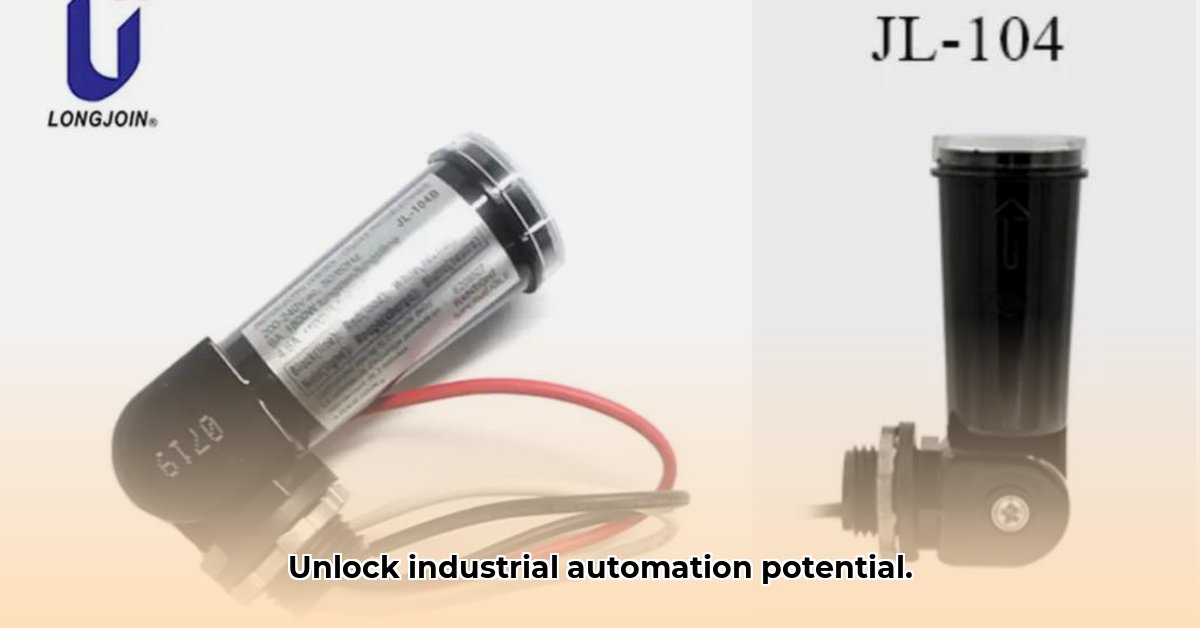
Choosing the right photoelectric sensor is crucial for efficient industrial automation. This guide provides a structured approach to selecting the optimal sensor for your specific needs, covering sensing modes, key selection criteria, light source options, practical considerations, and troubleshooting common issues. For more information on photoelectric sensors, check out this helpful resource: Lola Photoelectric Sensors.
Understanding Sensing Modes: Matching Sensor to Application
Photoelectric sensors utilize different sensing modes, each suited to specific applications. Understanding these differences is fundamental to successful sensor selection.
Through-Beam (Opposed-Mode): This method uses a separate emitter and receiver. A beam of light is transmitted between them; interruption triggers the sensor. (High accuracy, excellent for precise object detection in clean environments, but requires precise alignment and a clear line of sight.)
Retro-reflective: A single unit emits a light beam that reflects off a retroreflector back to the sensor. (Simple setup, cost-effective, but susceptible to interference from shiny surfaces or environmental factors.)
Diffuse-reflective: The sensor emits light; the reflected light from the target object triggers the sensor. (Easy installation, but less precise and sensitive to target reflectivity and ambient light.)
Background Suppression: This advanced mode filters out background light, enabling reliable detection even in cluttered environments. (Ideal for complex environments, but more expensive and complex to set up.)
Which sensing mode is best for detecting small parts moving on a conveyor belt in a clean environment? The through-beam method offers superior accuracy in such a scenario.
Key Selection Criteria: Prioritizing Essential Factors
Several critical factors influence sensor selection. Careful consideration of these parameters ensures optimal performance.
Sensing Range: The maximum distance at which the sensor reliably detects objects. (Consider the typical distance between sensor and target, as well as potential variations.)
Target Reflectivity: The object's ability to reflect light. Darker, less reflective surfaces necessitate higher sensor sensitivity. (Highly reflective surfaces can also cause issues; consider the target's material and finish.)
Ambient Light Conditions: External light sources can interfere with sensor readings. Select a sensor with sufficient immunity to ambient light. (Evaluate the lighting conditions in your application environment.)
Environmental Factors: Temperature, humidity, and vibration can impact sensor performance. Select a sensor with appropriate environmental ratings. (Industrial environments often demand robust, temperature-resistant sensors.)
Power Requirements: Ensure compatibility with your system's voltage and current capabilities. (Verify compatibility before purchase to avoid power supply problems.)
Communication Protocols: Choose a sensor with compatible communication protocols (e.g., analog, digital, or IO-Link) for seamless integration with your control system. (Check your control system's specifications to ensure compatibility.)
Did you know that improper sensor selection contributes significantly to automation system downtime? Choosing the right sensor reduces the risk of malfunction and potential production delays.
Choosing the Right Light Source: Optimizing Detection
The type of light source significantly impacts sensor performance. Each offers advantages and disadvantages:
Visible Red LED: Easily visible for alignment, but susceptible to ambient light interference. (Suitable for simple applications with minimal ambient light.)
Infrared (IR) LED: Less susceptible to ambient light, ideal for most industrial applications. (A good all-around choice providing balance between performance and cost.)
Long-Infrared (LIR) LED: Effective at detecting specific materials like water. (Excellent selection for applications requiring detection of specific materials.)
Laser: Provides high accuracy and longer range but requires careful handling and may pose eye safety considerations. (Ideal for long-range, precision applications.)
What light source is best suited for detecting transparent objects? IR or LIR LEDs are often better choices than visible red LEDs to detect transparent objects as they better penetrate certain materials.
Practical Considerations: Ensuring Reliable Operation
Proper sensor installation and configuration are essential for reliable operation.
Proper Alignment: Crucial for all sensing modes, especially through-beam and retro-reflective. (Precise alignment ensures accurate readings and prevents false triggering.)
Excess Gain: Adjusting the sensor's gain to compensate for low signal strength, but avoid over-amplification which can lead to false readings. (Find the optimal gain setting to balance sensitivity and noise reduction.)
Signal-to-Noise Ratio (SNR): A higher SNR indicates a clearer signal with less noise, leading to improved reliability. (Aim for a high SNR to minimize false positives.)
According to Dr. Anya Sharma, Lead Automation Engineer at Rockwell Automation, "Proper alignment and gain adjustment are critical for optimizing sensor performance and preventing costly downtime."
Troubleshooting Common Issues: Addressing Performance Problems
Common sensor problems often stem from simple causes:
Misalignment: Recheck sensor alignment to confirm proper beam path. * (Re-align carefully, using the sensor's alignment aids.)*
Dirty Lenses: Clean lenses with appropriate cleaning solutions and materials to remove dirt and debris obstructing the light path. (Regular cleaning extends sensor lifespan and improves accuracy.)
Faulty Wiring: Verify all connections to ensure proper power and signal transmission. * (Inspect wiring for damage or loose connections.)*
Incorrect Settings: Review and adjust sensor settings (e.g., sensitivity, time constant) based on the target and ambient conditions. (Consult the sensor's manual for specific guidelines.)
This guide provides a comprehensive framework for effective photoelectric sensor selection. By carefully considering the factors discussed, you can significantly improve the reliability and efficiency of your industrial automation systems. Remember that ongoing monitoring and maintenance are important to optimize sensor performance over time.